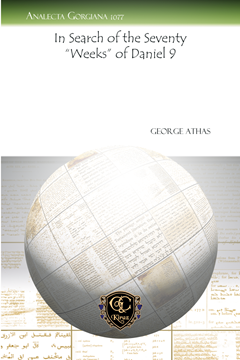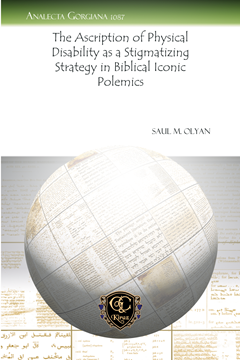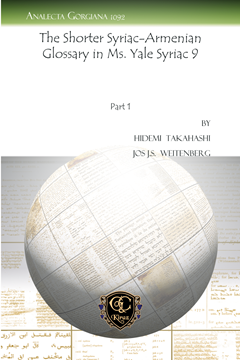Ephrem the Syrian's Hymns on the Unleavened Bread
Translation and Introduction by J. Edward Walters
Series: Texts from Christian Late Antiquity 30
ISBN: 978-1-4632-0159-3
In this set of homilies Ephrem (306-373) invites the reader into a world of symbolic interpretation filled with imagination brimming beneath the surface of word-plays, alliteration, and typological comparisons. These hymns thrust the reader into the middle of a context in which Christians and Jews maintain competing practices of a Passover service to the extent that Ephrem feels the need to distinguish between the symbol and the reality. These homilies are presented in their Syriac original alongside an annotated English translation.
$41.00 (USD) $24.60 (USD)
In Search of the Seventy "Weeks" of Daniel 9
By George Athas
Series: Analecta Gorgiana 1077
ISBN: 978-1-4632-0124-1
Athas challenges the past assumptions by Book of Daniel scholars, especially with regard to the symbolism in Chapter 9. This exegesis provides a theory for chronological interpretation that includes dates for calculating the seventy weeks mentioned in Daniel's vision.
$35.00 (USD) $21.00 (USD)
Persian Period Jerusalem and Yehud
A Rejoinder
Series: Analecta Gorgiana 1078
ISBN: 978-1-4632-0125-8
The author responds to criticism against his prior publications, when his conclusions were based foremost on the relevant archaeological findings. It is a debate between methodologies used by archaeology and the assumptions of textual analysis within biblical scholarship.
$33.00 (USD) $19.80 (USD)
The Contested History of a Book
The German Bible of the Later Middle Ages and Reformation in Legend, Ideology, and Scholarship
Series: Analecta Gorgiana 1079
ISBN: 978-1-4632-0126-5
This paper explores the common misconception that vernacular translations of the Bible were not available prior to Luther. In fact, Luther may have relied on these to accomplish his own work toward what became a more preferable translation.
$39.00 (USD) $23.40 (USD)
Priestly Power that Empowers
Michel Foucault, Middle-Tier Levites, and the Sociology of ‘Popular Religious Groups’ in Israel
Series: Analecta Gorgiana 1084
ISBN: 978-1-4632-0131-9
Christian analyzes priestly social dynamics in-depth as they develop through tribal history and specialization of tasks. He focuses on middle-tier Levites as their skills and specialized knowledge place them in upper classes but their work relegates them as intermediaries.
$51.00 (USD) $30.60 (USD)
The Ascription of Physical Disability as a Stigmatizing Strategy in Biblical Iconic Polemics
Series: Analecta Gorgiana 1087
ISBN: 978-1-4632-0134-0
This article presents the ascription of physical disability as a strategy to communicate disapproval of icons in various passages of the Hebrew Bible. Idols are characterized as unable to interact with worshipers and unable to function independently.
$34.00 (USD) $20.40 (USD)
A Perfectly Broken Acrostic in Nahum 1?
By Thomas Renz
Series: Analecta Gorgiana 1088
ISBN: 978-1-4632-0135-7
Renz discusses the acrostic poetic form of Nahum 1. The alphabetic sequence is interrupted by YHWH’s actions, conveying that this poem is a communication about divine order and chaos. This sets the tone for the flood motif in Nahum 2.
$37.00 (USD) $22.20 (USD)
Syriac into Armenian
The Translations and their Translators
Series: Analecta Gorgiana 1091
ISBN: 978-1-4632-0139-5
This article describes the historical development of Armenian translations of Syriac literature from the 5th century, Intervening- and Clinician Periods. Significant works and figures are highlighted.
$36.00 (USD) $21.60 (USD)
The Shorter Syriac-Armenian Glossary in Ms. Yale Syriac 9
Part 1
Series: Analecta Gorgiana 1092
ISBN: 978-1-4632-0140-1
Takahashi and Weitenberg provide the history and linguistic analysis of Ms. Yale Syriac 9. Only three such Syriac-Armenian lexica are known to survive. The glossary is classified as the Western branch of Modern Armenian, attributed to Dialect Group 5.
$34.00 (USD) $20.40 (USD)
The Syriac Presence in the Armenian Translation of the Bible, with Special Reference to the Book of
By Claude Cox
Series: Analecta Gorgiana 1093
ISBN: 978-1-4632-0141-8
Syriac and Armenian Christians interacted regionally and theologically. This paper investigates whether it is thus a viable proposition to deduce Syriac readings from Armenian biblical translations. Cox concludes on a case-basis because extensive use of a similar source text remains questionable.
$36.00 (USD) $21.60 (USD)









